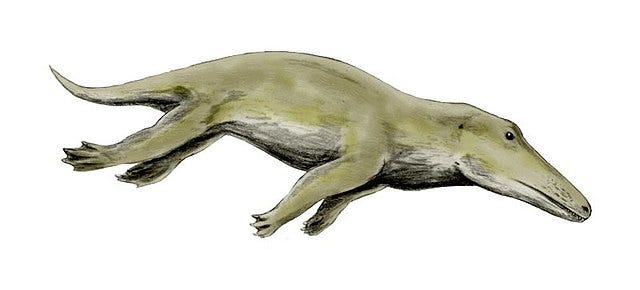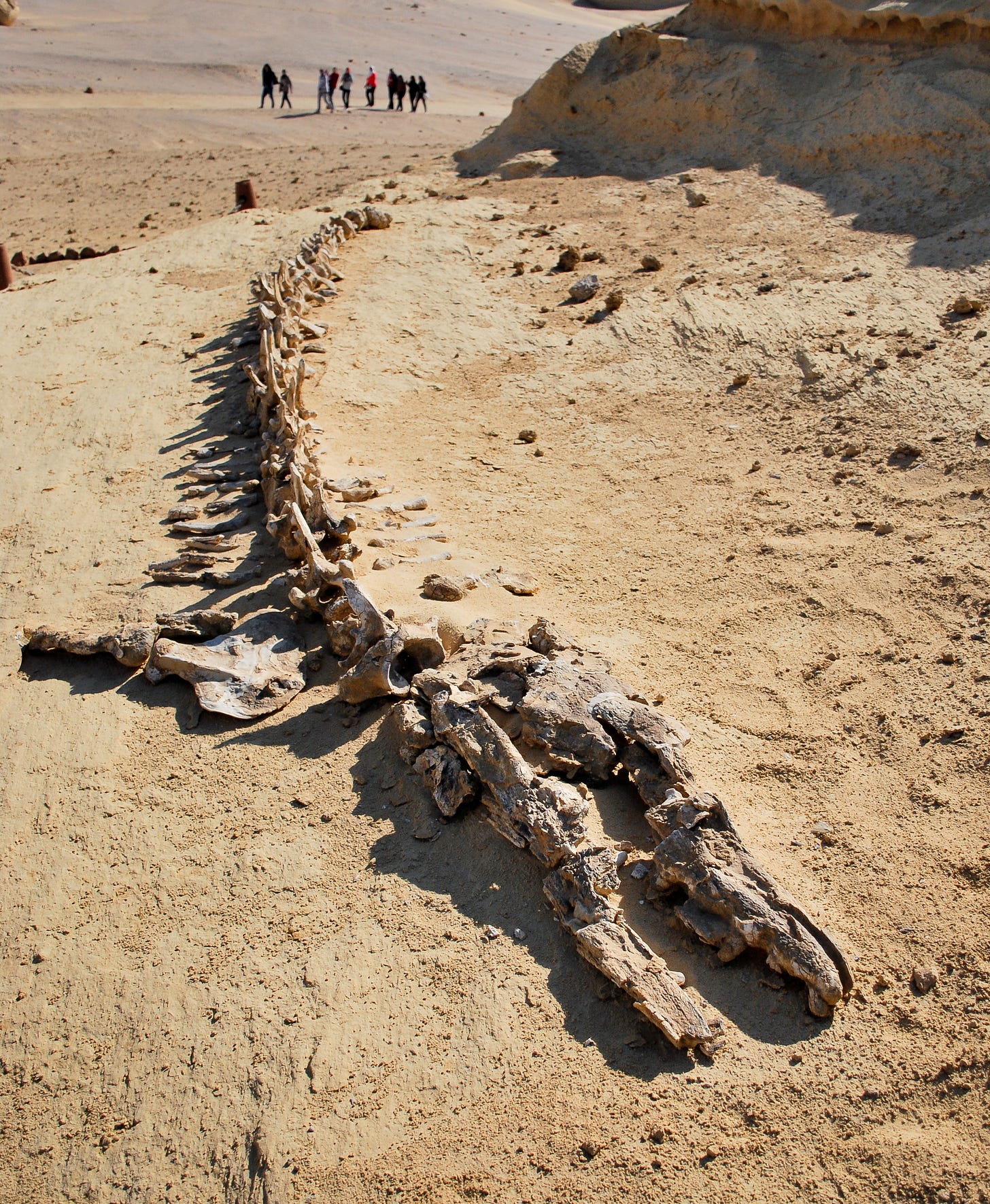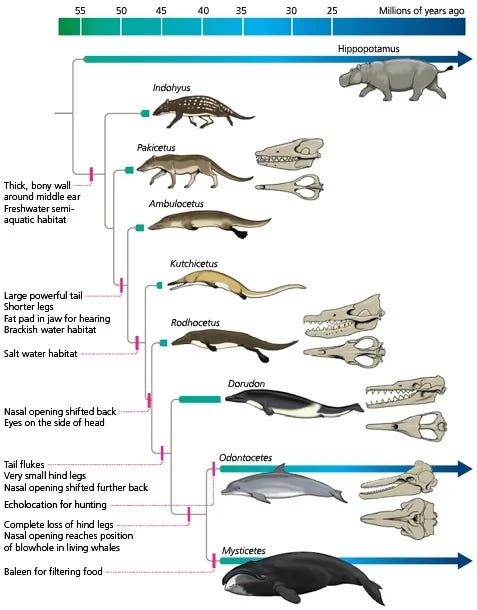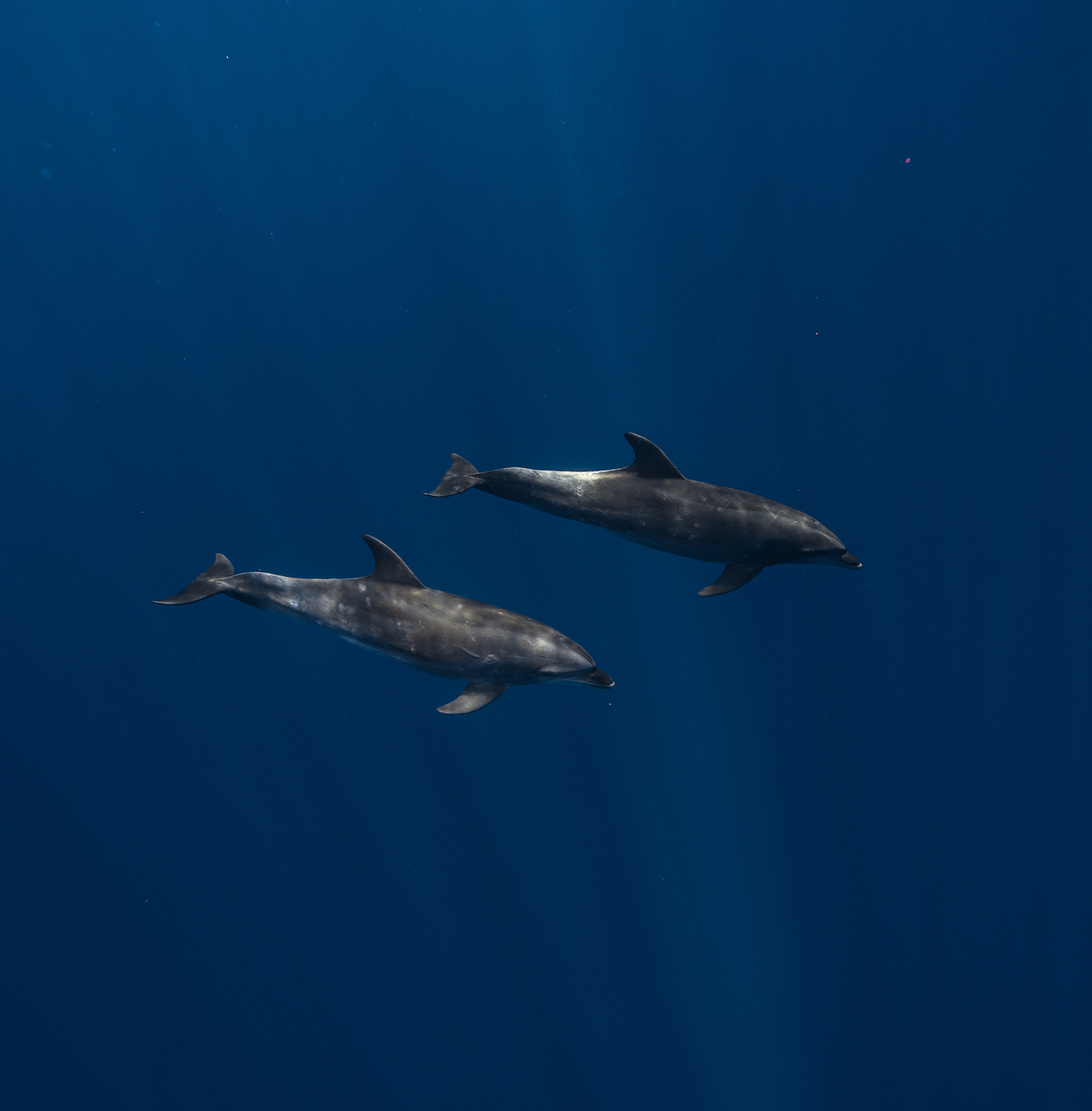The evolution of dolphins
From living on land to becoming the most intelligent species in the ocean
Dolphins are one of the most intelligent species on the planet, with a brain-to-body ratio second only to humans. Over millions of years, they have evolved the ability to problem solve, mimic, have empathy, experience grief, and pass their knowledge between one another in their complex social groups. They’ve developed echolocation which allows them to better sense their surroundings, and specialised brain cells called spindle neurons which aid in reasoning, understanding, and adapting to change.
Dolphins are very familiar to us, whether that’s because of our shared intelligence, their often gentle nature, or the healthy population size of many species meaning we’re lucky enough to catch a glimpse every now and then.
But how much do we really know about their evolutionary story?
First, I need to explain cetacean 101. All cetaceans (whales, dolphins, and porpoises) are either a baleen whale or a toothed whale. Baleen whales include humpbacks, blue whales, fin whales and 13 other species. Toothed whales include all species of dolphins and porpoises, as well as a few whales like sperm whales and narwhals. The overlap can get a little confusing and this is why Orcas (or killer whales) are often referred to as both a dolphin and a whale because technically they are both.
Much of the research into dolphin evolution also applies to other toothed whales, especially in the early stages but I’ll try and focus on dolphin-specific developments as much as possible.
Ancient whales
Just as it was in the story of whale evolution, the Pakicetus was a key figure in the origin of the dolphin. This land mammal, which lived around 50 million years ago (mya) and ate both meat and fish, was essentially the first whale, but instead of blowholes and flippers it had four legs and fur, and was about the same size as a modern-day wolf. How we know that the Pakicetus is an early ancestor of whales is due to its unique ear bone which is extremely similar to today’s whales and dolphins.
Just a few million years later, the descendants of the Pakicetus had begun wading back into the water, transitioning to an amphibious lifestyle. As marine food sources became more abundant, these pre-whales — known collectively as archaeocetes or ‘ancient whales’1—gradually gave up their life on land. A significant step in this evolution was Ambulocetus2. Similar to a crocodile, it thrived in both environments, with limbs strong enough to walk on land but a body increasingly built for swimming.
Between these two early whale species, incredible adaptations took place including developments in hearing. Unlike land mammals, which rely on an ear canal to funnel sounds, modern dolphins and whales pick up vibrations through a fat pad in their lower jaw. In Ambulocetus, this feature was notably larger than in the Pakicetus but smaller than in today’s species. This marks the start of a shift in what would eventually develop into the sophisticated echolocation that dolphins use today.
Not long after (at least in evolutionary terms) as archaeocetes started to officially leave land behind, came Protocetus. Belonging to the Protocetidae family, its more streamlined body and the early development of tail flukes made it better suited for deeper, open waters and less suited for the shallow coastlines where its ancestors had predominantly lived.
This shift coincided with the first major radiation event3 in cetacean evolution. A likely cause was a shift in ocean currents caused by separating land masses, which revealed new nutrient-rich waters for protocetids. This meant they could rapidly diversify at such a rate they were responsible for the first major geographic expansion, moving throughout North Africa, Europe, and North America.
One iconic species that benefited from this evolutionary explosion around 38 mya, was Basilosaurus. Despite its name (which means ‘king lizard’), Basilosaurus wasn’t a reptile but a long-bodied, fully aquatic mammal capable of growing up to 18 metres in length. Its visible hind limbs remained, but they were too small for walking. Still, it was a top predator of its time and one of the largest animals of the Paleogene. Often on its menu was the Dorudon—a smaller species from the same family4 which is thought to be more closely related to modern whales and dolphins than the Basilosaurus but still not necessarily a direct ancestor.
Dorudon were around five metres long with nostrils midway from their snout to the top of their head5, and showed features that visually align more clearly with the dolphin lineage. However, both the Dorudon and the Basilosaurus lacked the melon organ that their descendants use for echolocation, and the species, along with other archaeocetes, eventually went extinct leaving only the descendants of today’s extant species.
Birth of baleen
Around 34 mya, after the extinction of the archaeocetes, a second cetacean radiation occurred. Likely caused by the changing climate and altered ocean systems, these new ecological conditions favoured the evolutionary diversification of a new group of whales: the Neocetes or ‘new whales’. This group includes the ancestors of all living whales and dolphins, and marked a major turning point in their evolution.
This major radiation event also marks the split between baleen whales (Mysticeti) and toothed whales (Odontoceti)—the latter of which includes all dolphins, as it paved the way for two very different feeding strategies: filter feeding and echolocation. Early baleen whales likely had teeth as well as the beginnings of keratin baleen plates, but when a rapid shift in ocean temperature reduced the availability of prey, they were forced to adapt. Over time, these ‘new’ whales lost their teeth entirely, relying solely on baleen to feed on vast quantities of tiny prey like krill or plankton in one strained gulp, which became much more efficient for them. Underneath the soft baleen of modern species, traces of tooth development can still be found during early fetal stages, a clue to their dental past.
While baleen whales eventually lost their teeth, toothed whales survived by retaining theirs. Developing less sharp teeth to instead grasp and suck down their prey rather than chew allowed them to pursue larger, more agile prey6. What set them apart even more was their increasing reliance on echolocation—a sensory ability that would prove to be one of their greatest evolutionary advantages. This ability allowed them to hunt and navigate using sound instead of sight—a huge advantage in deep, dark waters.
Fossil evidence points to Squalodon, an extinct genus from around 33–14 mya, as one of the earliest whales to have the features associated with echolocation. Its skull shows signs of a compressed cranium and an extended snout. These could be the early adaptations that would eventually support the development of the melon organ used by modern dolphins to emit sound and ‘see’ with sonar. This development was pivotal. Unlike light, sound travels well through water, and echolocation allowed toothed whales to navigate, hunt, and communicate across longer distances and in deeper waters which meant a wider range of prey became available to them.
By the late Oligocene to mid-Miocene (around 23 mya), dolphin-like species had started to appear. One family in particular—Kentriodontidae—thrived during this time and is believed to include the ancestors of modern oceanic dolphins and porpoises. These small to medium-sized toothed whales were likely active echolocators and may have even formed pods or schools like today’s species, giving us one of the first glimpses into the social behaviours now so strongly associated with dolphins.
Dolphin diversity
As life during the Miocene progressed, the dolphin lineage continued to evolve. One final major cetacean radiation did occur between 12 to 2 mya, but it simply marked the broad expansion in the diversity of both baleen and toothed whales. This period saw the emergence of many familiar genera, including Balaenoptera (which now includes species like the blue whale and the fin whale) as well as the rise of the Delphinidae family aka oceanic dolphins.
From this family came an explosion of diversity. By the late Miocene, small, agile, and highly social dolphin species had started to spread into coastal and open ocean habitats. Species like the common dolphin, the spinner dolphin, and the Risso’s dolphin began to thrive across different marine environments, each with their own unique adaptations. And by around five mya, the genus Tursiops, which includes the bottlenose dolphin, had made its first appearance in the fossil record. Tursiops would go on to become one of the most recognisable dolphin genera, known for its intelligence and adaptability, with species like the Indo-Pacific bottlenose dolphin and the common bottlenose dolphin found in many coastal and offshore waters around the world.
By this point, dolphins had taken on many of the characteristics we recognise today: a streamlined body built for speed, sophisticated echolocation for navigation and hunting, and the capacity for complex social behaviours. They were mammals fully at home in the ocean but their fish-like appearance is worth explaining.
Like all cetaceans, dolphins are a perfect example of convergent evolution. Despite looking similar to fish or even extinct marine reptiles like ichthyosaurs, their flippers, dorsal fins, and torpedo-shaped bodies evolved entirely independently. These features emerged not from any shared ancestry but from facing similar environmental demands. In contrast, divergent evolution describes the process where closely related species evolve in different directions, often due to geographic isolation or different environmental pressures that have forced them to adapt in unique ways.
In just a few million years, the ocean had gone from being home to a handful of large, predatory whale species to supporting a wide variety of specialised cetaceans. No matter how they got there, the dolphin lineage was now firmly established. Today, there are around 40 extant species of dolphin, each highly intelligent. A question worth asking is if humans possess the emotional intelligence that dolphins do, to keep this beloved animal protected and free.
Here at Beached we are building a community that can put our brains and resources together to highlight and fund solutions to the problems facing all cetaceans. I hope you’ll join our humble community and click subscribe for free or support our work by purchasing the paid subscription.
All Beached posts are free to read but if you can we ask you to support our work through a paid subscription. These directly support the work of Beached and allow us to engage in more conversations with experts in the field of marine conservation and spend more time researching a wider breadth of topics for the newsletters. Paid subscriptions allow us to dedicate more time and effort to creating a community and provide the space for stakeholders to come together, stay abreast of each other’s work and foster improved collaboration and coordination.
One day Beached hope to donate a large percentage of the revenue from paid subscriptions to marine conservation organisations and charities to support their work too. Working together, we can reverse the degradation of our oceans.
Amie 🐋
Of which the Pakicetus was the first.
Which translates from Latin to ‘the walking whale’.
An evolutionary radiation is a significant increase in diversity caused by elevated rates of speciation.
Basilosauridae.
Slowly becoming less like nostrils and more like the blowholes we’re familiar with today.
Earlier species like Basilosaurus had different types of teeth and likely chewed their food.








What do you make of the new Google AI model that will (supposedly) figure out dolphin language? Odds of us learning how to communicate with Flipper? I’m skeptical but you would know more about this.
This was such a great read - thank you!